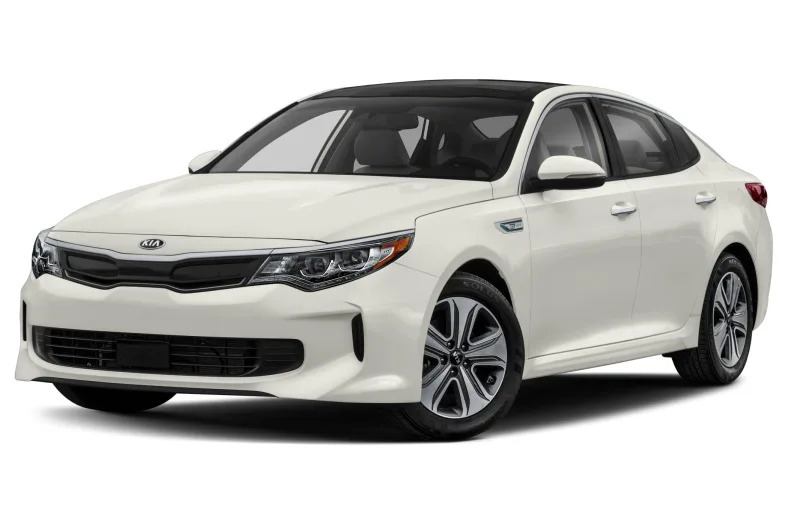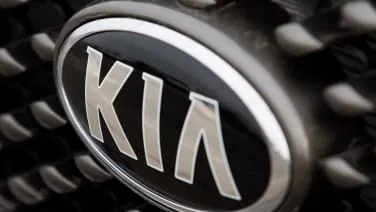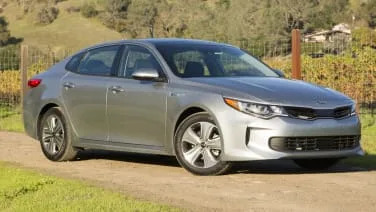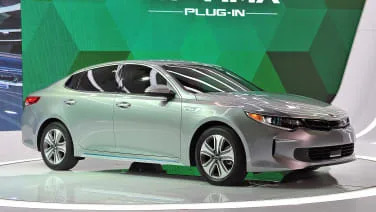2017 Kia Optima Hybrid
Automakers are stuck between a rock and hard place with hybrid vehicles. On one hand, efficient hybrids are a necessary evil – for lack of a better phrase – to hit increasingly stringent CAFE standards. But on the other hand, low fuel prices mean it takes an increasingly long time for consumers to see a return on the investment of a hybrid's price premium. These factors have pushed automakers even harder to squeeze every mile per gallon possible out their hybrid offerings. That's inevitably led to powertrain innovations designed to maximize just how long and how far hybrids can run on pure electric power and how often the gas engine can shut down. Occasionally, this doesn't work out all that well – as is the case with the new Nissan Rogue Hybrid, for instance – but there are companies getting things right. Kia, with its 2017 Optima Hybrid, is one of them. Drive Notes Kia didn't try to get too creative with the Optima Hybrid's powertrain for 2017. There's a 2.0-liter, naturally aspirated, four-cylinder gas engine, a 38-kilowatt electric motor, and a 1.62-kWh battery pack. Total system output is 192 horsepower and 271 pound-feet of torque, with EPA estimated fuel economy ratings of 39 miles per gallon in the city and 46 mpg on the highway for a 42-mpg combined rating. That's all spiffy. But taking a six-speed automatic and replacing the torque converter with a clutch and the electric motor, Kia built a hybrid sedan that smoothly intertwines disparate power sources as well as a conventional hybrid like a Toyota Prius, while allowing the Optima Hybrid to take greater advantage of zero-emissions systems. Lift off the throttle and the four-cylinder engine shuts down and lets the 50-hp electric motor handle light, constant-throttle cruising below 62 miles per hour. Dig deeper into the gas, and the petrol powerplant quickly restarts and delivers the bulk of the Optima's power for heavy acceleration and higher-speed conditions. The Optima's back and forth is rarely disjointed – Kia's hybrid feels a lot like its conventionally powered model in normal driving. It's only under sudden, wide-open throttle situations, where the hybrid systems feel caught off guard, that the Optima Hybrid feels flatfooted. A less obvious benefit of the six-speed automatic, of course, is that it leads to quieter operation. There's no rubber-band-like revving like you'd get with a CVT because the transmission can actually shift up a gear. Now, the Optima's 2.0-liter doesn't sound bad – we wouldn't complain about the noise if there was a CVT here – but the lack of noise is a pleasant side effect of the six-speed auto. The actual power on offer, meanwhile, falls somewhere between that of a base Optima and the turbocharged SX – unsurprisingly, there's a lot more low-end torque, owing to the electric motor. The Optima Hybrid feels snappier than the base, 2.4-liter Optima, but it fades at higher rpm and simply doesn't feel as potent as the 2.0-liter, turbocharged car. Powertrain tweaks aside, the …
Full Review
Automakers are stuck between a rock and hard place with hybrid vehicles. On one hand, efficient hybrids are a necessary evil – for lack of a better phrase – to hit increasingly stringent CAFE standards. But on the other hand, low fuel prices mean it takes an increasingly long time for consumers to see a return on the investment of a hybrid's price premium. These factors have pushed automakers even harder to squeeze every mile per gallon possible out their hybrid offerings. That's inevitably led to powertrain innovations designed to maximize just how long and how far hybrids can run on pure electric power and how often the gas engine can shut down. Occasionally, this doesn't work out all that well – as is the case with the new Nissan Rogue Hybrid, for instance – but there are companies getting things right. Kia, with its 2017 Optima Hybrid, is one of them. Drive Notes Kia didn't try to get too creative with the Optima Hybrid's powertrain for 2017. There's a 2.0-liter, naturally aspirated, four-cylinder gas engine, a 38-kilowatt electric motor, and a 1.62-kWh battery pack. Total system output is 192 horsepower and 271 pound-feet of torque, with EPA estimated fuel economy ratings of 39 miles per gallon in the city and 46 mpg on the highway for a 42-mpg combined rating. That's all spiffy. But taking a six-speed automatic and replacing the torque converter with a clutch and the electric motor, Kia built a hybrid sedan that smoothly intertwines disparate power sources as well as a conventional hybrid like a Toyota Prius, while allowing the Optima Hybrid to take greater advantage of zero-emissions systems. Lift off the throttle and the four-cylinder engine shuts down and lets the 50-hp electric motor handle light, constant-throttle cruising below 62 miles per hour. Dig deeper into the gas, and the petrol powerplant quickly restarts and delivers the bulk of the Optima's power for heavy acceleration and higher-speed conditions. The Optima's back and forth is rarely disjointed – Kia's hybrid feels a lot like its conventionally powered model in normal driving. It's only under sudden, wide-open throttle situations, where the hybrid systems feel caught off guard, that the Optima Hybrid feels flatfooted. A less obvious benefit of the six-speed automatic, of course, is that it leads to quieter operation. There's no rubber-band-like revving like you'd get with a CVT because the transmission can actually shift up a gear. Now, the Optima's 2.0-liter doesn't sound bad – we wouldn't complain about the noise if there was a CVT here – but the lack of noise is a pleasant side effect of the six-speed auto. The actual power on offer, meanwhile, falls somewhere between that of a base Optima and the turbocharged SX – unsurprisingly, there's a lot more low-end torque, owing to the electric motor. The Optima Hybrid feels snappier than the base, 2.4-liter Optima, but it fades at higher rpm and simply doesn't feel as potent as the 2.0-liter, turbocharged car. Powertrain tweaks aside, the …
Hide Full Review
Hide Full Review
Retail Price
$25,995 - $30,990
MSRP / Window Sticker Price
| Engine | I-4 |
| MPG | Up to 39 city / 46 highway |
| Seating | 5 Passengers |
| Transmission | 6-spd w/OD |
| Power | 154 @ 6000 rpm |
| Drivetrain | front-wheel |
| Curb Weight | 3,486 - 3,538 lbs |
Smart Buy Program is powered by 





